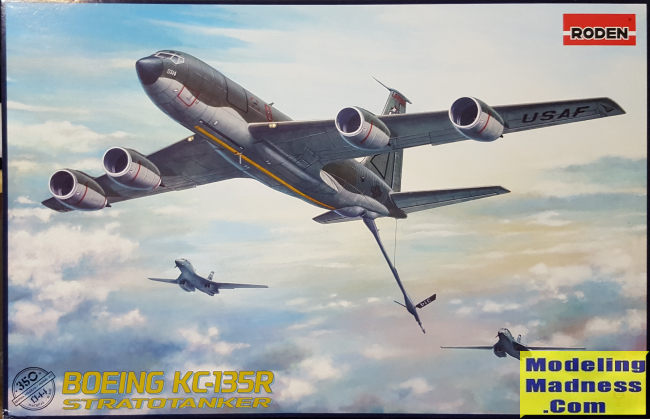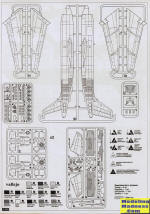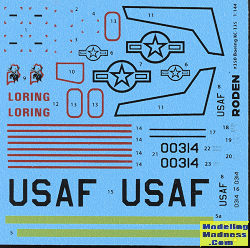
Roden 1/144 KC-135R Stratotanker
| KIT #: | 350 |
| PRICE: | $43.00 delivered from Ukraine |
| DECALS: | One option |
| REVIEWER: | Scott Van Aken |
| NOTES: |

| HISTORY |
The Boeing KC-135 Stratotanker is a military aerial refueling aircraft. It and the Boeing 707 airliner were developed from the Boeing 367-80 prototype. It is the predominant variant of the C-135 Stratolifter family of transport aircraft. The KC-135 was the US Air Force's first jet-powered refueling tanker and replaced the KC-97 Stratofreighter. The KC-135 was initially tasked with refueling strategic bombers, but was used extensively in the Vietnam War and later conflicts such as Operation Desert Storm to extend the range and endurance of US tactical fighters and bombers.
The KC-135 entered service with the United States Air Force (USAF) in 1957; it is one of six military fixed-wing aircraft with over 50 years of continuous service with its original operator. The KC-135 is supplemented by the larger KC-10. Studies have concluded that many of the aircraft could be flown until 2040, although maintenance costs have greatly increased. The aircraft will eventually be replaced by the Boeing KC-46 Pegasus, though that will take a long time as the first production aircraft wasn't delivered to the USAF until January 2019.
The KC-135R is the result of a second engine modification program which retrofitted 500 aircraft with new CFM International CFM56 (military designation: F108) high-bypass turbofan engines produced by General Electric and Snecma. The CFM56 engine produces approximately 22,500 lbf (100 kN) of thrust, nearly a 100% increase compared to the original J-57 engine. The modified tanker, designated KC-135R (modified KC-135A or E) or KC-135T (modified KC-135Q), can offload up to 50% more fuel (on a long-duration sortie), is 25% more fuel-efficient, and costs 25% less to operate than with the previous engines. It is also significantly quieter than the KC-135A, with noise levels at takeoff reduced from 126 to 99 decibels.| THE KIT |
 This
is not the first 1/144 KC-135R, with Minicraft offering the first one. Now we
have two of them with this recently released kit from Roden. Actually, the
timing is good as Minicraft is no longer a going concern. Just looking over the
sprues, it appears that Roden has more accurate engine nacelles and they got the
cockpit windows correct. A nice touch on the engines is that the forward cowling
is a separate piece so no worries on dealing with a seam.
This
is not the first 1/144 KC-135R, with Minicraft offering the first one. Now we
have two of them with this recently released kit from Roden. Actually, the
timing is good as Minicraft is no longer a going concern. Just looking over the
sprues, it appears that Roden has more accurate engine nacelles and they got the
cockpit windows correct. A nice touch on the engines is that the forward cowling
is a separate piece so no worries on dealing with a seam.
Roden has you build up the wings, complete with landing gear before attaching them to the fuselage. One also builds up the refueling boom at this time. The final step is to add the wings, tailplanes, fin tip, and the cockpit clear piece. There is no cockpit with this kit and really none is needed. What is needed is 20 grams of weight to keep it from tail sitting. It is fairly obvious from the sprues that the pieces for the EC-135 are included if you so wish to build that instead. Of course, you'll need to come up with markings.
 Instructions
are really nicely drawn though oddly, the inside of the sheet is upside down
compared to the outside. There are only 9 construction steps so this isn't a
really complex kit. The lone set of markings is pretty boring as it is a shamu
scheme aircraft that was assigned to the 42nd BW at Loring AFB. Fortunately,
there are aftermarket sheets for more interesting schemes. The sheet looks to be
nicely printed, though I have had issues with Roden decals adhering to anything
other than a flat surface in the past.
Instructions
are really nicely drawn though oddly, the inside of the sheet is upside down
compared to the outside. There are only 9 construction steps so this isn't a
really complex kit. The lone set of markings is pretty boring as it is a shamu
scheme aircraft that was assigned to the 42nd BW at Loring AFB. Fortunately,
there are aftermarket sheets for more interesting schemes. The sheet looks to be
nicely printed, though I have had issues with Roden decals adhering to anything
other than a flat surface in the past.
| CONCLUSIONS |
 This looks to be a very nice
kit. For sure it is not inexpensive, but it should sell quite well. One
thing to note is that on the aft fuselage, the reinforcing bands are
engraved when they should stand slightly proud. Another is that the APU
section is also engraved where it should also jut out a bit from the
surrounding fuselage. You can see what I mean from this photo section.
Minicraft got these right, though the reinforcements on that kit are a
bit too pronounced. Still, if you like the KC-135R, then this kit is
fairly widely available. Judging from the sprue layout, it should be no
real issue to do the earlier A or E models, though it would require
either new fuselage halves or some major filling as those did not have
the large APU section nor the reinforcements.
This looks to be a very nice
kit. For sure it is not inexpensive, but it should sell quite well. One
thing to note is that on the aft fuselage, the reinforcing bands are
engraved when they should stand slightly proud. Another is that the APU
section is also engraved where it should also jut out a bit from the
surrounding fuselage. You can see what I mean from this photo section.
Minicraft got these right, though the reinforcements on that kit are a
bit too pronounced. Still, if you like the KC-135R, then this kit is
fairly widely available. Judging from the sprue layout, it should be no
real issue to do the earlier A or E models, though it would require
either new fuselage halves or some major filling as those did not have
the large APU section nor the reinforcements. May 2023
Copyright ModelingMadness.com. All rights reserved. No
reproduction in part or in whole without express permission.
If you would like your product reviewed fairly and fairly
quickly, please
contact
the editor
or see other details in the
Note to
Contributors.